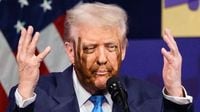United States President Donald Trump has stepped into the international spotlight once again, this time claiming credit for brokering a dramatic ceasefire between India and Pakistan after a heated aerial conflict in May 2025. Speaking at the Asia-Pacific Economic Cooperation (APEC) CEO Summit in Gyeongju, South Korea, on October 29, Trump recounted his version of events that, according to him, helped avert further escalation between the two nuclear-armed neighbors.
The recent standoff between India and Pakistan was the most intense military confrontation between the rivals in decades. The conflict erupted following a deadly attack in Indian-administered Kashmir on April 22, 2025, which killed 26 people. India swiftly blamed Pakistan for the assault, a charge Islamabad firmly denied, instead calling for a credible international investigation. What followed was an hour-long, nocturnal dogfight involving an estimated 110 aircraft—an engagement experts have described as the world’s largest air battle in years, according to reporting from Islamabad.
Pakistani officials claimed they downed six Indian jets, including French-made Rafale fighters, while India acknowledged losses but refrained from specifying numbers. Trump, however, put the tally at seven, calling them “brand new, beautiful” jets. “If you look at India and Pakistan, they were going at it, seven planes were shot down, and they were going at it, two big nuclear powers,” Trump said during a ceremony in Japan, as reported by Pakistani media outlets.
Trump’s account of the events suggests his influence was key in de-escalating the crisis. He claimed that his threat to halt trade with both India and Pakistan was “70 percent” responsible for ending not only their four-day standoff but also other international conflicts. “And I said to Prime Minister [Narendra] Modi, and I said to the Prime Minister [Shehbaz Sharif], a very nice man, a very good man. And the Field Marshal [Asim Munir] over in Pakistan, I said, ‘Look, we’re not going to do any trade if you’re going to be fighting’,” Trump recounted, as reported by The Express Tribune.
At the APEC summit, Trump expanded on his tactics, revealing that he had threatened both countries with a massive 250% tariff if they continued hostilities. “I warned of the tariffs. I said I’m going to put 250% tariffs on each country [if you don’t stop the war], which means that you’ll never do business,” Trump told the gathered business leaders. He claimed that this threat, coupled with his refusal to proceed with trade deals during the conflict, was instrumental in bringing both sides to the negotiating table.
“I’m doing a trade deal with India, and I have great respect and love for Prime Minister Modi. We have a great relationship,” Trump said, before adding, “Likewise, the Prime Minister of Pakistan is a great guy. They have a Field Marshal. You know why he’s a Field Marshal? He’s a great fighter. He’s a great guy too...And so I know them all.”
Trump’s recollection of his conversations with the leaders of India and Pakistan was characteristically colorful. “I called Prime Minister Modi and said, we can’t make a trade deal with you. [PM Modi said] No, no, we must make a trade deal. I said, no, we can’t. You’re starting a war with Pakistan. We’re not going to do it,” Trump recounted. He claimed to have delivered a similar message to Pakistan’s leadership: “We’re not going to do trade with you because you’re fighting with India. They said, ‘No, no, you should let us fight’. They both said that. They’re strong people.”
Trump’s praise for Modi was effusive and laced with his trademark bravado. “Prime Minister Modi is the nicest-looking guy. He’s a killer. He’s tough as hell,” Trump told the APEC audience. He then described the aftermath of his intervention: “After literally two days, they [India and Pakistan] called up and they said, we understand, and they stopped fighting. How is that? Isn’t that amazing? Now, you think Biden would have done that? I don’t think so.”
While Trump has repeatedly taken credit for the May 10 ceasefire between India and Pakistan—announcing the breakthrough on social media after Washington reportedly held talks with both sides—India has disputed his claims. Indian officials have maintained that the truce was not the result of U.S. intervention or Trump’s threats to halt trade, but rather a product of direct communication and their own diplomatic efforts.
Despite the differing narratives, the end of hostilities in May 2025 marked a turning point in the region. Since the ceasefire, Islamabad and Washington have expanded cooperation across a range of areas, including counterterrorism, defense, mining and minerals, trade, technology, and climate resilience. Both sides have signaled a renewed effort to stabilize ties and promote long-term collaboration, according to reports from Islamabad and Washington.
Trump’s remarks at the APEC summit were also notable for their timing and setting. He arrived in Gyeongju, South Korea, on October 29, 2025, to join other heads of state and business leaders for a series of summits and meetings. On October 30, he was scheduled to meet with Chinese President Xi Jinping, adding another layer of geopolitical significance to his statements about South Asia.
The former president’s comments also reflected his penchant for personal diplomacy and his willingness to leverage economic pressure as a tool for conflict resolution. By threatening sky-high tariffs and withholding trade deals, Trump positioned himself as the decisive actor who could bring nuclear-armed adversaries back from the brink. Whether or not his actions were as pivotal as he claims, there’s no doubt that his intervention was noticed in capitals across the world.
As the dust settles on the May 2025 conflict, questions remain about the true impact of Trump’s intervention and the durability of the peace between India and Pakistan. Both nations continue to harbor deep-seated mistrust and unresolved territorial disputes, particularly in Kashmir. Yet for now, the skies over South Asia are quiet, and the world’s attention has shifted—at least temporarily—to other flashpoints.
In a region where history is often measured in cycles of violence and uneasy truces, the story of how a U.S. president’s phone calls and tariff threats may have helped prevent a wider war is likely to fuel debate for years to come. One thing is certain: the events of May 2025, and the diplomatic drama that followed, will not soon be forgotten.




